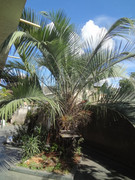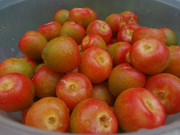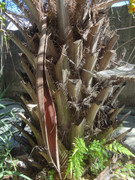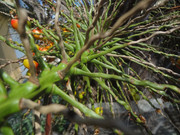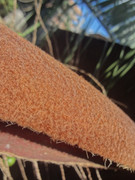981
« on: August 07, 2022, 03:00:48 PM »
Citrus is kindof unique among plants because some cultivars are polyembryonic and others are monoembryonic. Poly seeds will put up multiple sprouts. Some of those sprouts will be genetic clones of the mother tree (regardless of what pollinated the seed). The rate for clones varies by variety but can be as high as 98%. If you plant a mono seed, you can probably reverse that percentage (2% or less will be like the parent). I worked for a friend in his citrus nursery for a few months and one of my jobs was to remove off type seedlings or those that had "J" roots. It was rare to find off types and mostly I pulled "J" roots. However, one qualification for a good rootstock is that it grows true from seed. Even though fruit quality among rootstocks is poor, many of them are actually hybrids (Swingle, Carrizo, and X639 come to mind) but still grow true from seed. Rough Lemon, Cleopatra tangerine, and Smooth Flat Sevile sour orange are wild type (or close to it) citrus that are still used as rootstock and that we grew in the nursery as well. While I am not familiar with all citrus rootstocks, only two come to mind that produce a sweet scion quality fruit. One is the Duncan grapefruit (which was once used as a rootstock on flatwoods soils but fell out of favor due to susceptibility to foot rot). The other is Ridge Pineapple, a sweet orange cultivar which saw a brief surge in popularity after people lost whole groves on sour orange to tristezia (the sweet orange scions were resistant to tristezia but the sour orange roots they were on were not). It produces a fruit of excellent quality with a beautiful peel (although it is seedy). I have seen whole seedling groves of this variety in the wild (50 or more trees) that exibited very few differences in characteristics even though rough lemon, grapefruit, and a few tangerines were scattered through the same hammock and would surely have cross pollinated with the oranges. Out of the hunderds of citrus trees in that hammock (and many others), I have never found a hybrid tree. Ridge Pineapple is not used much as a rootstock anymore because it was water needy and better options for tristezia that still produced high brix fruit became more common (ie Swingle). In the nursery, we did no genetic testing and probably missed many seedlings that looked similar but were not true clones. This accounts for some of the variation in the growth and survival of trees that can be seen in a grove in my opinion. I have heard some reports that nurseries are having issues with some of the new USDA rootstocks not being reliable from seed. Other scion quality fruits that we have grown from seed include Orlando Tangelo and Meiwa kumquat. About half a dozen Orlando seedlings and a dozen meiwa kumquats all produced sweet fruit virtually indistiguishable from the parent tree. Persian lime was a miserable failure from seed--the fruits were dry and insipid nothing like the parent tree. Unlike older breeders who used a lot of polyembryonic varieties in their work, modern breeding programs typically use monoembryonic stock for breeding. This saves a lot of time sifting through the clones, but as a result many cultivars of recent development will not come true from seed.


